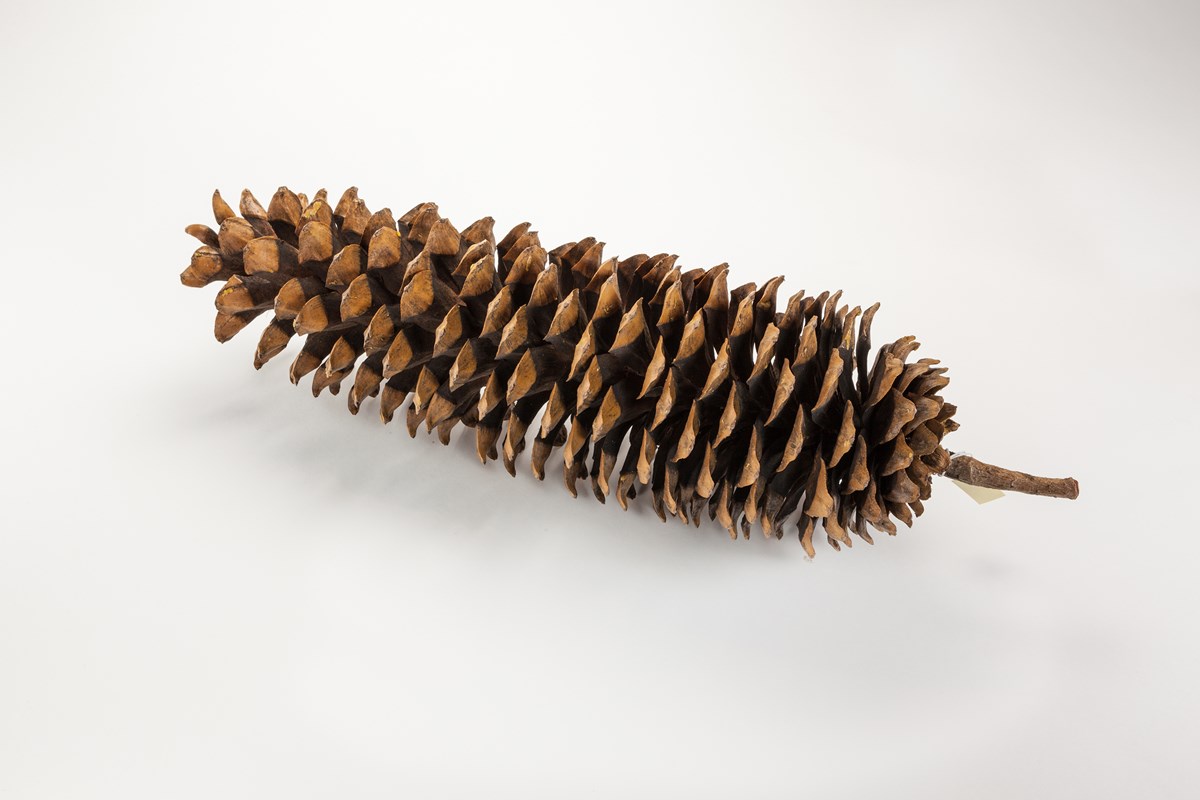What Do Sugar Pine Cones Look, and When Can You Pick Them

Willmcw, Public Domain, via Wikimedia Eatables
Full general Description
Saccharide pines (Pinus lambertiana) are the largest of the pine genus in both height and volume. The branches often sweep gracefully downward from the weight of their hefty cones, while their pyramidal crowns reach upwardly for the heaven. These deep-rooted pines with their dark green foliage are certain to stand out in every season.
Sugar pines commonly grow betwixt forty and 60 m (130–200 ft) alpine, with some growing upwards to 76 g (250 ft) tall. The mature trunks, distinguished by securely furrowed cinnamon-red bark, grow to 1.5–3 m (v–10 ft) wide. The sweeping branches incorporate needle leaves that are 8 cm (3 in) long and bundled in clusters of 5. Most notable are the massive, woody cones that may reach a length of over 51 cm (20 in), only boilerplate 30 cm (12 in) long and are commonly ten–fifteen cm (4–6 in) wide. The cones fill with plump seeds that mature in late Baronial and often counterbalance several pounds!
Habitat and Distribution
Where are these coniferous forest giants found? In 1826, famous Scottish botanist-explorer, David Douglas, first noticed the sugar pine on the headwaters of the Umpqua River in Oregon. Native to the Pacific coast mountains, they grow in dry to moist, mixed-conifer forests primarily along the westward gradient of the Cascade Range from the due north central Cascades in Oregon and south into the Siskiyou, Klamath, and Sierra Nevada mountains. Smaller, isolated populations are constitute in the Coast Range of southern Oregon and California, and in this species' southernmost extent, on a high plateau in the Sierra de San Pedro Mártir Mountains of Baja California Norte, Mexico. Sugar pines occur at elevations from 183 1000 (600 ft) (rare) with Coast redwoods, to three,353 chiliad (11,000 ft) (upper limit) on Mount San Pedro in southern California, but they are almost commonly found at 914–1829 m (3,000–vi,000 ft) elevation.

NPS
Life Cycle
Saccharide pines, like other pine species, produce both male and female cones. Male person cones are smaller and less noticeable. The scales of male cones are closely knit together and grow on lower branches of the tree. Female cones abound on higher branches. At maturity, male cones release pollen, which travel to the female cones past wind or by insects for pollination. Seeds grow inside the hardened scales of female cones, and fertilization occurs about 12 months after pollination. It tin have many years for a cone to develop, become fertilized, and produce seeds. The well-nigh productive seed years are every three–5 years. The seeds are mainly dispersed past animals (birds and mammals) and air current.
Each carbohydrate pine seed is adorned with a 2 cm (0.75 in) long wing, which helps with dispersal. The one cm (0.5 in) long seed flies on the wind until gravity takes concur. And then, the seed drops, settles into the soil, and if atmospheric condition are favorable, it begins to grow. From a seedling to a sapling with smooth gray bark, information technology matures to eventually produce long slender purplish cones. A sugar pine can grow into a stately woods giant that can alive upward to 500 years and more!
Ethnobotanical Significance
Native American people in the region used the sugariness tasting sap of sugar pine equally a food condiment and medicine. The seeds are a nutritious food source—a type of edible pino nut. The nuts were oft roasted or pounded into cakes and stored for the wintertime. The blackish brownish basics were besides used as decorative beads in jewelry.
Early European settlers used sugar pines for timber. The wood is renowned for existence lightweight (despite its massive volume), knotless, and very directly. Sugar pine lumber is used to make storage containers, wide knotless boards, and piano and organ keys.
Conservation
Saccharide pines are susceptible to white pino blister rust (Cronartium ribicola) infection and mount pine beetle (Dendroctonus ponderosae) attack. Other factors such every bit climate change, wildfire suppression, and logging make saccharide pines vulnerable.
Where to See
Saccharide pines are present in all Klamath Network parks, but just commonly found in Whiskeytown NRA, Lassen Volcanic NP, and Oregon Caves NM&P.
More Information
Source: https://www.nps.gov/articles/000/sugar-pine.htm
Post a Comment for "What Do Sugar Pine Cones Look, and When Can You Pick Them"